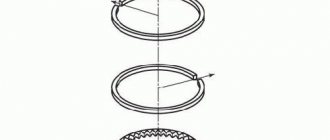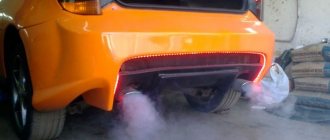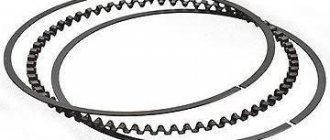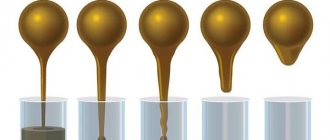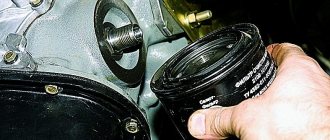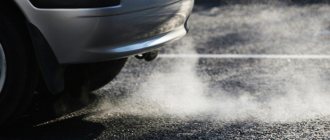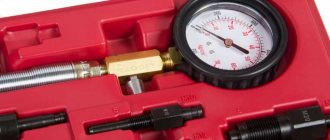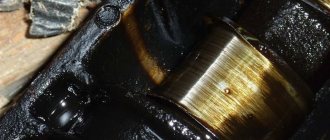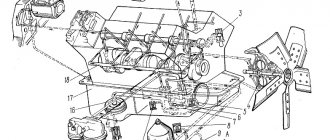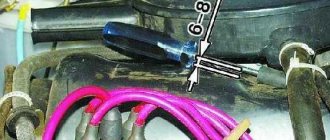What are piston rings for?
Piston rings are necessary to create compression in the combustion chamber of the cylinder, which is a necessary condition for the operation of the air-fuel mixture during ignition.
Most often, the compression should be at least 10 “points” , but on some engine models a lower figure is the norm. Combustion gases cannot pass through the gaps, since they are reliably protected by the engine's piston compression rings.
The engine also contains rings for removing excess oil from the cylinder. They are, accordingly, called oil scrapers. This ensures good lubrication in the engine cylinders and also reduces the risk of engine oil getting into the combustion chamber.
How to understand that the piston rings are stuck
Let's start with the fact that most often the oil scraper rings are installed first, and only then the compression rings. The list of main signs of stuck piston rings includes:
- the engine is difficult to start when cold;
- the engine smokes blue or gray oil smoke;
- the power unit does not develop full power;
- compression in the cylinders is reduced;
If the engine is difficult to start when cold, there is an increased consumption of engine oil and the power unit “does not pull”, then it is necessary to measure the engine compression. If the piston rings are stuck in the cylinders, the compression ratio of the fuel-air mixture decreases, resulting in the above-mentioned cold start problems.
An increase in engine oil consumption and smoking makes it possible to determine with a high degree of probability that the rings are stuck. This is due to the fact that during engine operation, part of the lubricant penetrates through the leaks between the rings and the wall into the combustion chamber, where the oil is then heavily consumed as waste. In this case, the engine emits blue exhaust. Blue engine smoke is especially noticeable after warming up, as well as with increasing speed under load.
We also recommend reading the article on how to measure engine compression yourself. From this article you will learn about ways to accurately measure compression in the cylinders of a power unit.
Selecting additives for oil scraper rings
- Liqui Moly logo
Liqui Moly
How can you navigate the choice of additive for restoring oil scraper rings for engine operation that can be considered normal? A good example would be those variants of multifunctional additives that were the first to be used in motor oil for BelAZ loading equipment. Indeed, soon after a series of successful experiments it turned out that these additives are perfectly suitable for other lubricants. One of these additives at that time was the most successful invention of the Liqui Moly company - OL-VERLUST-STOP. Today, thanks to its well-established production, this miracle can be found in any stores and shops specializing in the sale of auto chemicals in sufficient quantities. OL-VERLUST-STOP is a universal tool for stopping engine oil leaks. It can cure minor ailments of rubber gaskets and seals, eliminating the possibility of oil getting into the environment, and reduces oil consumption. But most importantly, this product protects oil scraper rings from grease waste products, restoring them to their former mobility. This occurs due to the stabilization of the oil viscosity at fairly high temperatures.
But the company decided not to stop there either. L-Shclamm-Splung is an excellent additive for combating black sludge in the engine. It is extremely important to avoid its accumulation, since it settles not only on the oil scrapers, but also clogs the oil receiver mesh, oil channels and filters. The liquid completely cleans the internal combustion system, ensuring the absence of “lubricant starvation”.
- XADO and Edial
Another good option is detergent and anti-wear additives in the oil. Among these, it is worth highlighting revitalizants under the XADO brand, of which there are more than enough on the Russian car market, as well as the friction modifier Edial. The latter is a multifunctional additive used to restore worn rubbing metal surfaces. It increases the service life of engine mechanisms and restores their structure as well as if it was done manually. The same applies to their beneficial effect on oil scraper rings. With its polygamous compatibility with all known oils for diesel and gasoline engines, Edial “Internal Combustion Engine” is one of the best means of cleaning oil scraper rings from carbon deposits.
- Additives from the American manufacturer
Hi-gear
Even a novice motorist is familiar with the phrase “Hi-gear”. This American company develops and produces all the auto chemicals you can think of. So they also invented something for oil scraper rings. Oil Treatment HG2243 and HG2246 are two high-tech additives that can do a lot: they will prevent oil oxidation and its dilution, restore their former strength to exhausted additives in the lubricant mixture and increase compression. As practice shows, all rings present in the engine behave as well as possible when interacting with these substances, and the overall dynamics of the vehicle improves. These additives will cure even moderate ring damage, something that many others cannot boast of. Experts recommend adding them to the oil of cars with high and medium mileage.
Americans constantly delight the four-wheeled (and not only) world with new arrivals. To some extent, the company can even be called an auto pharmacy. Among the latest special products, we should mention such as HG2219 (contains SMT2) for washing six- and eight-cylinder “stomachs” of vehicles. HG2214 is practically the same, but with a milder principle of action, conditioning of the insides of the engine and a small content of “Friction Winner” as an auxiliary active ingredient. And don't forget about rinsing with HG2217. Return to content
What to do if the rings wear out?
In order to choose a way to solve a problem, you need to find out why it arose. The occurrence of the above symptoms may be caused by wear or breakage of the compression and oil rings, or if they are coked and stuck.
In the first case, it will be necessary to disassemble the engine and install new parts instead of damaged ones. In this case, you should carefully inspect all mating parts, since if the rings break, scoring may occur, which can only be eliminated by carrying out a major overhaul.
If there is an assumption that the piston and oil scraper rings are stuck, then you can add a special additive to the oil. But this method is used, as a rule, for preventive purposes.
Malfunctions related to piston rings arise in practice quite often. Therefore, in order to prevent serious consequences and, as a result, high repair costs, it is necessary to recognize their first symptoms in time and take appropriate measures.
FEATURES OF OIL RING INSTALLATION
I would like to draw your attention to the installation of oil scraper rings. There should be no problems with compression if you follow simple rules, install them with the inscriptions facing up (inscriptions, dot) and use a special tool.
When installing oil scraper valves, difficulties may arise if there are no inscriptions, or if the expander lock is installed correctly. Let's look at this in more detail. If there are no inscriptions, then it does not matter which side you put the ring on and which one will be on top and which one will be on the bottom (inlaid).
Often errors occur when installing the piston into the cylinder, even if a special clamp is used to tighten the rings on the piston. The peculiarity is as follows. When assembling the oil scraper ring, you should pay attention to the expander lock and the correctness of its docking. For clarity, see the image below.
During compression of the rings on the piston, the lock of the oil scraper ring expander can jump out of the correct position and overlap, gathering in a spiral, so the plates fall through the expander and this will lead to scuffing of the cylinder walls and piston grooves. To avoid this, the tightening clamp should be positioned as shown in the image.
What is the expression “the rings are stuck”?
First, let's figure out how the cylinder-piston group works. While the engine is running, the piston moves back and forth inside the cylinder. There must be a gap between these parts so that friction does not interfere with movement.
At the same time, the contact between the piston/cylinder parts should be as tight as possible in order to:
- make maximum use of the energy of expanding gases;
- do not let combustion products into the crankcase;
- When moving downwards, remove any lubricant that has got on the inner wall of the cylinder.
To meet these conditions, in most cases of passenger cars, three rings are installed on each piston: two compression rings and one oil scraper ring. Compression rings are usually “solid” in cross-section, while oil scraper rings have a slot in which a spring is installed, and on the outside they have a removal edge and slits for removing oil. Thanks to this design, the rings are springy and fit tightly to the cylinder walls.
The piston has three grooves, the width of which is hundredths of a millimeter greater than the thickness of the piston rings. Therefore, the rings are always fixed and have freedom of movement, tightly closing the gap.
When carbon or coke accumulates in the piston grooves, it acts as glue. The rings simply stick to the grooves, lose mobility and cannot elastically press against the cylinder walls, resulting in a violation of the tightness of the piston/cylinder pair. This phenomenon is called bedding or coking. We figured out why the rings lie, now we’ll find out how to diagnose it all.
- For naturally aspirated petrol engines up to 1.6 litres. Restores and equalizes compression, reduces fuel and oil consumption due to waste, protects friction surfaces in the CPG and gas distribution mechanism from wear during startup and overheating.
Removing carbon deposits with water
Some motorists have learned to use a milder procedure that has the same effect in removing carbon deposits as chemicals. Decarbonization with water is the most common method that owners of domestic and imported cars decide to use.
For the procedure you will need:
- distilled water in a plastic bottle;
- dropper;
- hose (for windshield washer);
- tee (connect the washer).
The scheme of work is as follows: water from a bottle is connected through a dropper to the engine suction. You can use non-distilled water - the filtration system in the dropper itself will handle the cleaning. Water supply starts with the engine running - at approximately 2000 rpm.
2-3 drops per second is enough when the engine is idling when the engine is warm. The effect will not take long to appear, the carbon deposits are removed, and the car becomes dynamic and economical.
Let's sum it up
For cars of recent vintage, the cleaning procedure will help get rid of problems with compression, loss of engine power and dark smoke exhaust from the car muffler, or in especially severe cases it will show that a major overhaul is indispensable.
In any case, we advise you, before going to a car service center for major repairs, to try to decoke the oil scraper rings in the engine on your own, using any of the methods described above. This way you can save your money and time.
Also, many motorists have noticed the fact that after cleaning the power unit from carbon deposits, the consumption of gasoline and oil is significantly reduced. In any case, preventative cleaning of the cylinders before changing the oil never hurts. We hope that after reading our article you will no longer have the question of what to do if the rings are stuck in the engine. We wish you good luck and success on the road!
Video “Coking rings”
This video shows what to do if the piston rings are stuck. What are the best products to use and how to use them correctly.
You can often hear the phrase that the engine is the heart of the car. This is true. The main characteristic that determines the reliability of an engine is its resource. Based on this, you can judge whether the car as a whole is reliable or not. After all, engine repair is always a complex and expensive operation. Car owners often encounter the phenomenon of stuck rings in the engine. What to do in such a situation, what is the cause of the malfunction? All this and more will be discussed further in the article.
Signs of stuck piston rings
Symptoms of stuck compression and oil rings are as follows:
- High oil consumption;
- Blueish smoke comes out of the car's exhaust pipe;
- Compression in the cylinders has decreased;
- The car began to pick up speed more slowly due to deteriorating engine performance;
- The engine starts worse in the cold season.
In particularly advanced situations, you may smell a burning smell in the cabin when the engine is running.
Signs of buried rings
Previously, we found out that when the rings are stuck in the engine, the tightness of the piston to the cylinder is broken. It follows from this that gases from the combustion chamber partially “fly” into the resulting gap, without performing useful work, they enter the crankcase.
Symptoms of stuck rings are mainly caused by a drop in compression in the combustion chamber due to gaps between the piston cup and the liner wall. Problems begin with a deterioration in the dynamic characteristics of the car. The engine does not respond well to the gas pedal. This is the main sign.
If the oil scraper rings are stuck, a film of lubricant remains on the inner surface of the cylinder (by the way, compression rings get stuck much less often). During the power stroke of the piston, when fuel vapors ignite, the lubricating fluid burns out. The oil is wasted, and bluish smoke comes out of the exhaust pipe. This is the second sign.
Difficulty starting the engine in any weather is another sign of stuck rings. The crankshaft with counterweights has a large mass and requires significant force to turn it. In addition, the oil flows into the oil pan; at the first revolutions, the friction force also impedes the movement of the piston. If one or more cylinders are not firing, starting is difficult.
Increased fuel consumption may also be a sign that there are rings in the engine. Due to the gap between the piston and the cylinder, the energy of the fuel is not fully used: compression is insufficient. Therefore, the on-board computer overestimates the enrichment of the air-fuel mixture to compensate for the lack of thrust. This leads to excessive consumption of fuel.
Decarbonization of rings
So, having recognized the above symptoms, you have discovered that there are compression or oil rings stuck in the engine and you are wondering what should be done first. How can the situation be resolved with the least damage to the affected unit? Let's try to figure it out together!
If the rings are stuck, it is not at all necessary to rush to the nearest workshop or urgently call a specialist, whose services will not be cheap. The problem can easily be fixed on your own.
To do this, it will be necessary to carry out the so-called decoking of the rings, based on the removal of various deposits, such as coke and soot, from the internal space of the combustion chamber. It is the formation of these substances that causes the piston seals to stick, limiting the necessary mobility.
Let's consider the most accessible way to decarbonize the rings yourself, without removing the engine. It involves cleaning the combustion chamber with special compounds. So that you don’t have to rack your brains about how to replace the piston rings later, we recommend using this method.
There is a fairly wide range of such products available on the automotive market. Among the variety of products offered to caring owners of personal vehicles by the chemical industry, a composition called Lavr is in high demand.
However, domestic car enthusiasts are not accustomed to using ready-made products, preferring, in order to save money, to do everything with their own hands from scrap materials.
Recommendations for eliminating problems with stuck piston rings yourself
Enterprising Russian owners of personal vehicles have come up with their own cleaning product to remove deposits from the internal space of the cylinders. The following provides step-by-step instructions for cleaning the combustion chamber with a mixture of acetone and kerosene:
- before freeing the rings from plaque and deposits, without disassembling the entire power unit, you must first disconnect all the wires and remove the spark plugs;
- It should be taken into account that proper cleaning of the chamber is only possible if there is a complete absence of oil in the system. Therefore, before starting decoking of the piston rings, the lubricating oil product is drained from the engine;
- then, simultaneously, the working space of all cylinders is filled with a mixture of kerosene and acetone prepared in advance;
Means for decoking piston rings
Modern manufacturers offer a lot of liquids for decarbonization. Any car enthusiast will be able to choose the appropriate option based on the situation with the rings and financial capabilities.
For example, the Mitsubishi Shumma decarbonizer from a Japanese company has a fairly high price, but has increased efficiency. It is introduced into the cylinders through a tube and left for half an hour.
Kangaroo ICC300 fluid is also a good option, although it is not intended directly for engine decarbonization. Its advantage is that it also cleans the throttle valve.
VeryLube, a good anti-coke agent, is designed to remove various types of contaminants. But it is worth using it when the coking is not yet too strong. Otherwise, the product will be useless.
The Greenol Reanimator chemical copes well with carbon deposits, but can lead to swelling of the valve stem seals.
Causes of stuck piston rings
Poor warming up of a cold engine. Although most modern engine manufacturers claim that there is no need to warm up the power unit, practice shows the opposite. Regular driving on a cold engine, especially when the engine receives heavy loads immediately after starting, leads to engine malfunction. A cold motor that has received a load wears out without proper lubrication and with gaps in parts that disappear only after warming up.
Low quality motor oil. Those who like to save on oil for their engine risk completely ruining the engine. Low-quality oil does not have the proper tolerances, detergent components, and also does not have the necessary fluidity, therefore, it cannot create a dense oil film.
How to protect your car from carbon deposits?
- driving at low speeds should be as gentle as possible;
- the shorter the period of vehicle downtime, the less slagging of the piston rings;
- in cold weather, good warming up is required;
- timely oil changes will reduce the amount of carbon deposits;
- the use of additives will increase the service life of the engine by 40 thousand km.
If the problem already exists, the car consumes more oil and gasoline, fumes and smokes, learn how to decarbonize the engine yourself. And may your “iron horse” never fail!
Did you like the article? Show it to your friends:
Do-it-yourself additives or soft decarbonization
Decarbonization of piston rings can be carried out in a gentle way, accessible to any car enthusiast. It involves simply adding special substances to the fuel, offered in car dealerships.
They must be poured according to the instructions. Soft decarbonization is carried out without dismantling spark plugs or injectors; it does not require adding new engine oil.
But there are also disadvantages: not a single fuel additive can cope with severe coking. Also, such substances cannot decarbonize the combustion chamber and valves.
Therefore, if the problem is pronounced, then it is better to pay attention to a harsh method of cleaning the engine.
Decarbonization of piston rings
If there are piston rings stuck in the engine, you will one way or another have to find out what piston ring decarbonization is. This procedure can be carried out in different ways, the most popular of which I will describe below.
- Method one . A composition of kerosene and acetone in equal proportions is poured into the combustion chambers through spark plug wells. Next, the motor is given time to oxidize, usually a day or a day, depending on the degree of contamination. After this, the spark plugs are screwed into place, and the engine, after normal warming up, is given a normal load while driving. This could be a highway and good acceleration, during which the engine can “cough up” all the dirt and carbon deposits contained in the cylinders. After completing this procedure, it is necessary to replace the engine oil, oil and fuel filters.
- Method two . In the same way, a special wash is poured into the chambers, which can dissolve carbon deposits and unblock the engine piston rings. There are a lot of different products on the market designed to do this job, so there is no point in naming specific brands. The method of application is approximately the same, but it is still better to follow the instructions for using a particular chemical.
If after washing the piston rings are still stuck, the only option left is to overhaul the engine and replace the piston rings. Overhauling an engine may not be the most pleasant undertaking, but in some cases this is the optimal solution that can quickly and reliably save you from the problem of stuck rings.
What is the danger of a situation where rings are stuck in the engine?
The main danger is that when the piston rings are stuck, the engine operates in abnormal mode:
- incomplete combustion of fuel, formation of soot;
- failure of individual cylinders;
- exhaust gases penetrate the crankcase, oil destruction;
- the oil burns, forming varnishes and carbon deposits.
Long-term engine flushing "Suprotek Aprokhim"
Over the course of 200 kilometers, it gently and gradually cleanses all parts of the engine from contaminants and helps restore the mobility of the piston rings. Safe for rubber and plastic parts.
more reviews
These seemingly minor faults lead to serious problems and expensive repairs.
When aggressive exhaust gases enter the oil pan, they react with the oil. The chemical composition of the lubricating fluid changes, it cannot perform its functions. As a result, wear of rubbing parts accelerates and heat dissipation deteriorates.
Oil that is not removed by the stuck oil scraper ring burns, causing local overheating of the parts. With prolonged use in this mode, scuffing will appear on the liner and piston skirt. When the oil burns, it leaves carbon deposits, which often causes detonation and possible piston burnout.
How can I prevent this from happening in the future? Prevention is better than cure!
A number of simple rules should be followed to avoid a similar phenomenon in the future.
- First of all, you should warm up the engine for at least a few minutes, and after starting to move, try to move at minimum speed until the engine reaches the desired temperature.
- Do not skimp and fill only high-quality oil into the engine. Good oil is the key to the success of any mechanism. Using good oil, you can avoid engine problems, as well as avoid the appearance of soot, deposits and other troubles.
- Carry out intermediate inspections. If possible, do preventive examinations from specialists, measure compression in the cylinders, check the condition of the spark plugs, monitor the cleanliness of the exhaust, and also conduct comprehensive computer diagnostics of the power unit and all its systems.
Only this approach will allow you to protect yourself and avoid possible problems with piston rings and CPG. However, even if you had to deal with the problem of stuck piston rings, you shouldn’t be too upset, any breakdown can be repaired, and a car is, first of all, hardware that breaks down regardless of brands and prices. The main thing is to have health and the desire to fix it all. Stay safe and thank you for reading to the end.
That’s all I have, I would be grateful if you share this article on social networks using the special buttons located under the article. Bye everyone, good luck!
Decent care contributes to a significant increase in the trouble-free operation of the vehicle. It is also guaranteed by regular maintenance, vigilant monitoring of the condition of consumables and timely replacement of worn or deformed parts that threaten impending failure.
Regardless of the time the power unit is used, mileage of more than 150 thousand km usually affects its performance, causing significant problems. Among them, we can note the unpleasant situation with the occurrence of piston rings.
Timely detection and immediate elimination of such a malfunction can protect the car owner’s wallet from significant costs for unplanned engine overhauls.
Prevention Tips
The main reasons for engine coking are known; it is possible if:
- the car stood idle for several months, and then they began to use it,
- only short trips are constantly made when the engine does not have time to fully warm up;
- low-quality engine oil is used, or the replacement interval is regularly exceeded.
This means that in order to reduce the risk of piston rings sticking, you need to follow simple rules:
- If your car has been sitting idle for a long time, change the oil before you start driving it.
- Take long trips from time to time to allow the engine to warm up and the deposits to burn off completely.
- Fill only with the grades of motor oil recommended by the vehicle manufacturer.
Remember that it is easier to prevent any problem than to deal with it later.
Prerequisites for the occurrence of rings
During long-term operation of the engine, a large layer of soot forms on its elements. This is considered to be the main reason causing the occurrence of rings. And the main prerequisites for the formation of excessive amounts of soot are:
- short driving on an insufficiently warmed up engine. Short distances of 5-10 km are considered especially dangerous;
- various damage to valve stem seals, up to complete failure;
- lubricants of insufficient quality poured into the power unit. It should be noted that oil with the proper level of properties does not burn out in the engine, maintaining the specified initial characteristics;
- The last cause of excessive carbon formation is untimely replacement of lubricant. The manufacturer's recommendations should be carefully followed, limiting the period of use of the petroleum product. Also, do not forget to change the oil filter regularly and on time.
Each of the listed conditions can cause unwanted carbon formation. And this, in turn, leads to the occurrence of rings. Coking of the grooves negatively affects the quality of the seal, limiting the required mobility of the elements.
Prevention and control of ring deposits
If the piston rings are stuck, it is not at all necessary to go to a car service center and pay for engine repairs. There is a fairly effective way to restore their mobility on your own. It is necessary to mix kerosene and acetone in equal proportions, pour the resulting mixture into the cylinders and leave for several hours (optionally, overnight). During this time the deposits will become soaked. Then all that remains is to screw in the spark plugs, start the engine and drive 10-15 kilometers in low gear with high revs.
It is desirable that the tachometer needle stays in the region of 5.5–6 thousand rpm. During the trip, the cylinder-piston group should completely clean itself. This will become clear from the increased thrust of the power unit. If the symptoms of the occurrence have not disappeared, you can repeat the soaking procedure again. Instead of the kerosene-acetone mixture, you can purchase special products at the auto store. After the problem is fixed, you need to change the engine oil and oil filter, since both are unsuitable for further use.
If, despite all efforts, the problem remains, it means that the rings are not stuck, but are physically worn out, in which case a major overhaul is inevitable.
Preventing a problem is easier than solving it, so to avoid rings getting stuck, you need to make fairly long trips by car at least once a month (at least 50 kilometers). When traveling, you should sometimes let the engine run at high speeds (about 4 thousand rpm) for one to two minutes. During this time, the soot, if there was any, will have time to completely burn out.” alt=””>
Prolonged operation of the internal combustion engine, untimely oil changes, use of low-quality lubricants, as well as certain engine problems can lead to a frequent and widespread problem - stuck piston rings. The main reason for the occurrence of rings is active carbon formation and coking in the engine combustion chamber.
In parallel with the formation of carbon deposits, coking of the piston ring grooves occurs, as a result of which these rings lose their mobility and are unable to provide proper sealing. Often, coking of the combustion chamber of a working engine, as a result of which the piston rings become stuck without other visible reasons, occurs in the following cases:
- if the car is constantly driven without pre-warming the engine in difficult conditions. These include short-term city trips at low speeds; the engine does not have time to reach operating temperatures and quickly cokes.
- the engine is filled with oil different from that recommended by tolerances or of low grade, and the interval for its recommended replacement is constantly extended, etc.
We also recommend reading the article about whether motor oils can be mixed.
From this article you will learn about the features of selecting a lubricant for the engine, as well as the need to use flushes before changing the oil. In the first case, lubricant of unsuitable properties or low quality gets into the combustion chambers abundantly, is heavily wasted and causes coking of the engine. In the second case, the oil recommended for use in this type of engine simply loses its properties from prolonged use. Next, we will look at the main signs by which you can determine the occurrence of piston rings, and also talk about available ways to eliminate such a malfunction with your own hands.
Additional recommendations for drivers
There is another way to clean the components of the cylinder from carbon deposits, which was used by Soviet car enthusiasts. For this we need ordinary paint solvents and kerosene. You will have to partially disassemble the power unit and clean it manually. An ordinary washcloth, rags and a cotton swab, which can be used to reach hard-to-reach areas, will help us with this. Even such cleaning well restores compression, power, dynamic performance, and reduces fuel consumption due to better combustion of the working mixture from the cylinders. Here's a look at what the pistons look like before and after cleaning.
I would like to draw the attention of those car owners who are planning to carry out such an operation with their own hands. Often, to achieve the desired effect, you may need not only special equipment and expensive car cosmetics, but also certain skills. They are owned by service station workers who have repeatedly cleaned the rings. But in some cases it can become the last hope, which will save the power unit from major expensive repairs. Cleaning products make it possible to do without rebuilding the engine, but this is not always the case. This is why it is recommended to periodically perform decarbonization as a preventive measure.
The best way to clean carbon deposits from rings is up to you to decide for yourself, based on the information above. The main thing is that you need to promptly monitor and take care of your engine. It is for these purposes that we are organizing a small practical “educational program” here. We will say goodbye and see you again!
